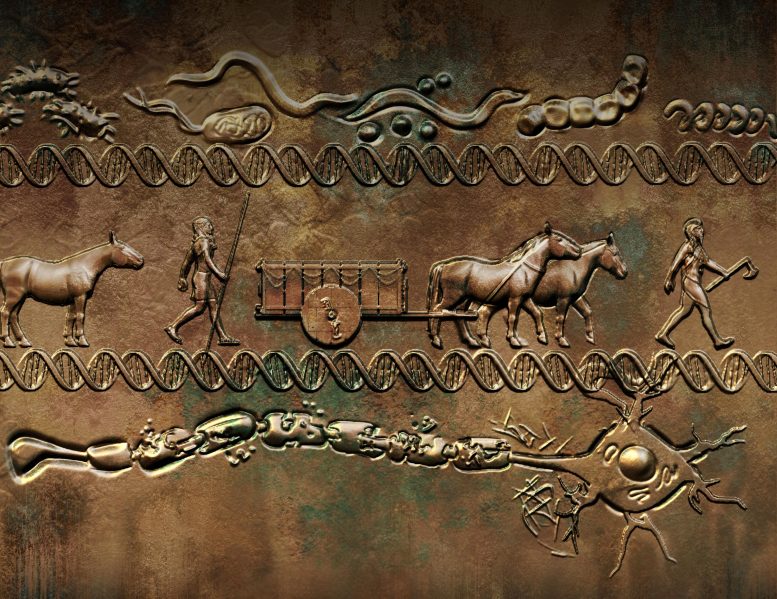
The new study has found the genes that significantly increase a person’s risk of developing multiple sclerosis (MS) were introduced into north-western Europe around 5,000 years ago by sheep and cattle herders migrating from the east. Credit: SayoStudio
A significant study reveals that genes associated with multiple sclerosis were introduced to north-western Europe 5,000 years ago by migrating livestock herders, impacting modern susceptibility to the disease.
Researchers have created the world’s largest ancient human gene bank by analyzing the bones and teeth of almost 5,000 humans who lived across Western Europe and Asia up to 34,000 years ago.
By sequencing ancient human DNA and comparing it to modern-day samples, the international team of experts mapped the historical spread of genes – and diseases – over time as populations migrated.
The ‘astounding’ results have been revealed in four trailblazing research papers published in the journal Nature and provide new biological understanding of debilitating disorders.
The extraordinary study involved a large international team led by Professor Eske Willerslev at the Universities of Cambridge and Copenhagen, Professor Thomas Werge at the University of Copenhagen, and Professor Rasmus Nielsen at University of California, Berkeley, and involved contributions from 175 researchers from around the globe.
The scientists found:
- The startling origins of neurodegenerative diseases including multiple sclerosis
- Why northern Europeans today are taller than people from southern Europe
- How major migration around 5,000 years ago introduced risk genes into the population in north-western Europe – leaving a legacy of higher rates of MS today
- Carrying the MS gene was an advantage at the time as it protected ancient farmers from catching infectious diseases from their sheep and cattle
- Genes known to increase the risk of diseases such as Alzheimer’s and type 2 diabetes were traced back to hunter gatherers
- Future analysis is hoped to reveal more about the genetic markers of autism, ADHD, schizophrenia, bipolar disorder, and depression
Northern Europe has the highest prevalence of multiple sclerosis in the world. A new study has found the genes that significantly increase a person’s risk of developing multiple sclerosis (MS) were introduced into north-western Europe around 5,000 years ago by sheep and cattle herders migrating from the east.
By analyzing the DNA of ancient human bones and teeth, found at documented locations across Eurasia, researchers traced the geographical spread of MS from its origins on the Pontic Steppe (a region spanning parts of what are now Ukraine, South-West Russia, and the West Kazakhstan Region).
They found that the genetic variants associated with a risk of developing MS ‘traveled’ with the Yamnaya people – livestock herders who migrated over the Pontic Steppe into North-Western Europe.
These genetic variants provided a survival advantage to the Yamnaya people, most likely by protecting them from catching infections from their sheep and cattle. But they also increased the risk of developing MS.
“It must have been a distinct advantage for the Yamnaya people to carry the MS risk genes, even after arriving in Europe, despite the fact that these genes undeniably increased their risk of developing MS,” said Professor Eske Willerslev, jointly at the Universities of Cambridge and Copenhagen and a Fellow of St John’s College, an expert in analysis of ancient DNA and Director of the project.
He added: “These results change our view of the causes of multiple sclerosis and have implications for the way it is treated.”
The age of specimens ranges from the Mesolithic and Neolithic through the Bronze Age, Iron Age, and Viking period into the Middle Ages. The oldest genome in the data set is from an individual who lived approximately 34,000 years ago.
The findings provide an explanation for the ‘North-South Gradient’, in which there are around twice as many modern-day cases of MS in northern Europe than in southern Europe, which has long been a mystery to researchers.
From a genetic perspective, the Yamnaya people are thought to be the ancestors of the present-day inhabitants of much of North-Western Europe. Their genetic influence on today’s population of southern Europe is much weaker.
Previous studies have identified 233 genetic variants that increase the risk of developing MS. These variants, also affected by environmental and lifestyle factors, increase disease risk by around 30 percent. The new research found that this modern-day genetic risk profile for MS is also present in bones and teeth that are thousands of years old.
“These results astounded us all. They provide a huge leap forward in our understanding of the evolution of MS and other autoimmune diseases. Showing how the lifestyles of our ancestors impacted modern disease risk just highlights how much we are the recipients of ancient immune systems in a modern world,” said Dr William Barrie, a postdoc in the University of Cambridge’s Department of Zoology and co-author of the paper.
Multiple sclerosis is a neurodegenerative disease in which the body’s immune system mistakenly attacks the ‘insulation’ surrounding the nerve fibres of the brain and spinal cord. This causes symptom flares known as relapses as well as longer-term degeneration, known as progression.
Professor Lars Fugger, a co-author of the MS study professor and consultant physician at John Radcliffe Hospital, University of Oxford, said: “This means we can now understand and seek to treat MS for what it actually is: the result of a genetic adaptation to certain environmental conditions that occurred back in our prehistory.”
Professor Astrid Iversen, another co-author based at the University of Oxford, said: “We now lead very different lives to those of our ancestors in terms of hygiene, diet, and medical treatment options and this combined with our evolutionary history means we may be more susceptible to certain diseases than our ancestors were, including autoimmune diseases such as MS.”
The Lundbeck Foundation GeoGenetics Centre – the resource underpinning the discoveries
The new findings were made possible by the analysis of data held in a unique gene bank of ancient DNA, created by the researchers over the past five years with funding from the Lundbeck Foundation.
This is the first gene bank of its kind in the world and already it has enabled fascinating new insights in areas from ancient human migrations, to genetically-determined risk profiles for the development of brain disorders.
By analyzing the bones and teeth of almost 5,000 ancient humans, held in museum collections across Europe and Western Asia, the researchers generated DNA profiles ranging across the Mesolithic and Neolithic through the Bronze Age, Iron Age, and Viking period into the Middle Ages. They compared the ancient DNA data to modern DNA from 400,000 people living in Britain, held in the UK Biobank.
“Creating a gene bank of ancient DNA from Eurasia’s past human inhabitants was a colossal project, involving collaboration with museums across the region,” said Willerslev.
He added: “We’ve demonstrated that our gene bank works as a precision tool that can give us new insights into human diseases, when combined with analyses of present-day human DNA data and inputs from several other research fields. That in itself is amazing, and there’s no doubt it has many applications beyond MS research.”
The team now plans to investigate other neurological conditions including Parkinson’s and Alzheimer’s diseases, and psychiatric disorders including ADHD and schizophrenia.
They have received requests from disease researchers across the world for access to the ancient DNA profiles, and eventually aim to make the gene bank open access.
The research was funded by a €8M grant from the Lundbeck Foundation, and conducted at the Lundbeck Foundation Geogenetics Centre at the University of Copenhagen.
Jan Egebjerg, Director of Research at the Lundbeck Foundation, said: “The rationale for awarding such a large research grant to this project, as the Lundbeck Foundation did back in 2018, was that if it all worked out, it would represent a trail-blazing means of gaining a deeper understanding of how the genetic architecture underlying brain disorders evolved over time. And brain disorders are our specific focus area.”
References:
- “Elevated genetic risk for multiple sclerosis emerged in steppe pastoralist populations” by William Barrie, Yaoling Yang, Evan K. Irving-Pease, Kathrine E. Attfield, Gabriele Scorrano, Lise Torp Jensen, Angelos P. Armen, Evangelos Antonios Dimopoulos, Aaron Stern, Alba Refoyo-Martinez, Alice Pearson, Abigail Ramsøe, Charleen Gaunitz, Fabrice Demeter, Marie Louise S. Jørkov, Stig Bermann Møller, Bente Springborg, Lutz Klassen, Inger Marie Hyldgård, Niels Wickmann, Lasse Vinner, Thorfinn Sand Korneliussen, Morten E. Allentoft, Martin Sikora, Kristian Kristiansen, Santiago Rodriguez, Rasmus Nielsen, Astrid K. N. Iversen, Daniel J. Lawson, Lars Fugger and Eske Willerslev, 10 January 2024, Nature.
DOI: 10.1038/s41586-023-06618-z - “The selection landscape and genetic legacy of ancient Eurasians” by Evan K. Irving-Pease, Alba Refoyo-Martínez, William Barrie, Andrés Ingason, Alice Pearson, Anders Fischer, Karl-Göran Sjögren, Alma S. Halgren, Ruairidh Macleod, Fabrice Demeter, Rasmus A. Henriksen, Tharsika Vimala, Hugh McColl, Andrew H. Vaughn, Leo Speidel, Aaron J. Stern, Gabriele Scorrano, Abigail Ramsøe, Andrew J. Schork, Anders Rosengren, Lei Zhao, Kristian Kristiansen, Astrid K. N. Iversen, Lars Fugger, Peter H. Sudmant, Daniel J. Lawson, Richard Durbin, Thorfinn Korneliussen, Thomas Werge, Morten E. Allentoft, Martin Sikora, Rasmus Nielsen, Fernando Racimo and Eske Willerslev, 10 January 2024, Nature.
DOI: 10.1038/s41586-023-06705-1 - “Population genomics of post-glacial western Eurasia” by Morten E. Allentoft, Martin Sikora, Alba Refoyo-Martínez, Evan K. Irving-Pease, Anders Fischer, William Barrie, Andrés Ingason, Jesper Stenderup, Karl-Göran Sjögren, Alice Pearson, Bárbara Sousa da Mota, Bettina Schulz Paulsson, Alma Halgren, Ruairidh Macleod, Marie Louise Schjellerup Jørkov, Fabrice Demeter, Lasse Sørensen, Poul Otto Nielsen, Rasmus A. Henriksen, Tharsika Vimala, Hugh McColl, Ashot Margaryan, Melissa Ilardo, Andrew Vaughn, Morten Fischer Mortensen, Anne Birgitte Nielsen, Mikkel Ulfeldt Hede, Niels Nørkjær Johannsen, Peter Rasmussen, Lasse Vinner, Gabriel Renaud, Aaron Stern, Theis Zetner Trolle Jensen, Gabriele Scorrano, Hannes Schroeder, Per Lysdahl, Abigail Daisy Ramsøe, Andrei Skorobogatov, Andrew Joseph Schork, Anders Rosengren, Anthony Ruter, Alan Outram, Aleksey A. Timoshenko, Alexandra Buzhilova, Alfredo Coppa, Alisa Zubova, Ana Maria Silva, Anders J. Hansen, Andrey Gromov, Andrey Logvin, Anne Birgitte Gotfredsen, Bjarne Henning Nielsen, Borja González-Rabanal, Carles Lalueza-Fox, Catriona J. McKenzie, Charleen Gaunitz, Concepción Blasco, Corina Liesau, Cristina Martinez-Labarga, Dmitri V. Pozdnyakov, David Cuenca-Solana, David O. Lordkipanidze, Dmitri En’shin, Domingo C. Salazar-García, T. Douglas Price, Dušan Borić, Elena Kostyleva, Elizaveta V. Veselovskaya, Emma R. Usmanova, Enrico Cappellini, Erik Brinch Petersen, Esben Kannegaard, Francesca Radina, Fulya Eylem Yediay, Henri Duday, Igor Gutiérrez-Zugasti, Ilya Merts, Inna Potekhina, Irina Shevnina, Isin Altinkaya, Jean Guilaine, Jesper Hansen, Joan Emili Aura Tortosa, João Zilhão, Jorge Vega, Kristoffer Buck Pedersen, Krzysztof Tunia, Lei Zhao, Liudmila N. Mylnikova, Lars Larsson, Laure Metz, Levon Yepiskoposyan, Lisbeth Pedersen, Lucia Sarti, Ludovic Orlando, Ludovic Slimak, Lutz Klassen, Malou Blank, Manuel González-Morales, Mara Silvestrini, Maria Vretemark, Marina S. Nesterova, Marina Rykun, Mario Federico Rolfo, Marzena Szmyt, Marcin Przybyła, Mauro Calattini, Mikhail Sablin, Miluše Dobisíková, Morten Meldgaard, Morten Johansen, Natalia Berezina, Nick Card, Nikolai A. Saveliev, Olga Poshekhonova, Olga Rickards, Olga V. Lozovskaya, Olivér Gábor, Otto Christian Uldum, Paola Aurino, Pavel Kosintsev, Patrice Courtaud, Patricia Ríos, Peder Mortensen, Per Lotz, Per Persson, Pernille Bangsgaard, Peter de Barros Damgaard, Peter Vang Petersen, Pilar Prieto Martinez, Piotr Włodarczak, Roman V. Smolyaninov, Rikke Maring, Roberto Menduiña, Ruben Badalyan, Rune Iversen, Ruslan Turin, Sergey Vasilyev, Sidsel Wåhlin, Svetlana Borutskaya, Svetlana Skochina, Søren Anker Sørensen, Søren H. Andersen, Thomas Jørgensen, Yuri B. Serikov, Vyacheslav I. Molodin, Vaclav Smrcka, Victor Merts, Vivek Appadurai, Vyacheslav Moiseyev, Yvonne Magnusson, Kurt H. Kjær, Niels Lynnerup, Daniel J. Lawson, Peter H. Sudmant, Simon Rasmussen, Thorfinn Sand Korneliussen, Richard Durbin, Rasmus Nielsen, Olivier Delaneau, Thomas Werge, Fernando Racimo, Kristian Kristiansen and Eske Willerslev, 10 January 2024, Nature.
DOI: 10.1038/s41586-023-06865-0 - “100 ancient genomes show repeated population turnovers in Neolithic Denmark” by Morten E. Allentoft, Martin Sikora, Anders Fischer, Karl-Göran Sjögren, Andrés Ingason, Ruairidh Macleod, Anders Rosengren, Bettina Schulz Paulsson, Marie Louise Schjellerup Jørkov, Maria Novosolov, Jesper Stenderup, T. Douglas Price, Morten Fischer Mortensen, Anne Birgitte Nielsen, Mikkel Ulfeldt Hede, Lasse Sørensen, Poul Otto Nielsen, Peter Rasmussen, Theis Zetner Trolle Jensen, Alba Refoyo-Martínez, Evan K. Irving-Pease, William Barrie, Alice Pearson, Bárbara Sousa da Mota, Fabrice Demeter, Rasmus A. Henriksen, Tharsika Vimala, Hugh McColl, Andrew Vaughn, Lasse Vinner, Gabriel Renaud, Aaron Stern, Niels Nørkjær Johannsen, Abigail Daisy Ramsøe, Andrew Joseph Schork, Anthony Ruter, Anne Birgitte Gotfredsen, Bjarne Henning Nielsen, Erik Brinch Petersen, Esben Kannegaard, Jesper Hansen, Kristoffer Buck Pedersen, Lisbeth Pedersen, Lutz Klassen, Morten Meldgaard, Morten Johansen, Otto Christian Uldum, Per Lotz, Per Lysdahl, Pernille Bangsgaard, Peter Vang Petersen, Rikke Maring, Rune Iversen, Sidsel Wåhlin, Søren Anker Sørensen, Søren H. Andersen, Thomas Jørgensen, Niels Lynnerup, Daniel J. Lawson, Simon Rasmussen, Thorfinn Sand Korneliussen, Kurt H. Kjær, Richard Durbin, Rasmus Nielsen, Olivier Delaneau, Thomas Werge, Kristian Kristiansen and Eske Willerslev, 10 January 2024, Nature.
DOI: 10.1038/s41586-023-06862-3


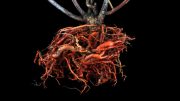
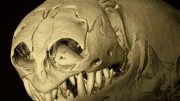
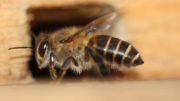


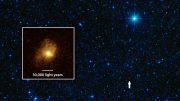
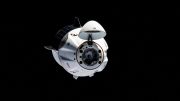
Not bad, it only took them, 175 researchers from around the globe, 8 million Euros and five years to determine what I did gradually and intermittently at home on my own about two decades ago. Like food allergy reactions, neurodegenerative diseases are more prevalent among meat eaters, with allergies being to proteins. First writing the US FDA (with replies) of my early lay findings of connections between allergies, added MSG, chronic disease and obesity in October of 2005, which I’ve now been writing on for eighteen years and counting to more than 4,000 professionals of various relevant disciplines and counting, updating as possible, I wonder how many more researchers, Euros and years it will take for them to discover that the allergies are genetic but the diseases are not. Therefore, the best ways to treat the diseases are to help victims identify their individual allergic offenders, avoid toxic allergy aggravating food additives like added soy, MSG, aspartame, propylene glycol, HFCS and a more recent serious concern for me, the cooking oil preservative TBHQ, and/or get those additives (minimally) banned. Foods should be as natural, pure and safe as possible. Too bad the emphasis will likely be on developing new drugs to treat mere symptoms, which won’t address the underlying causes.